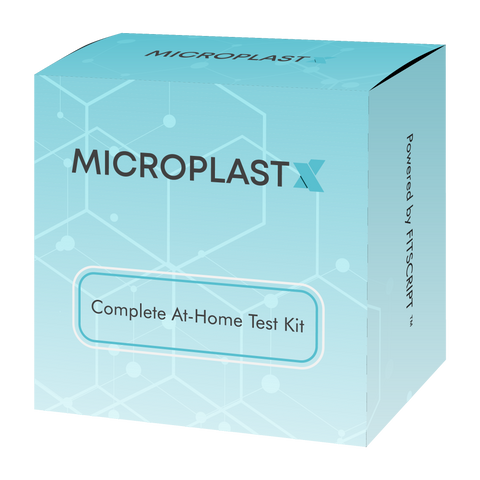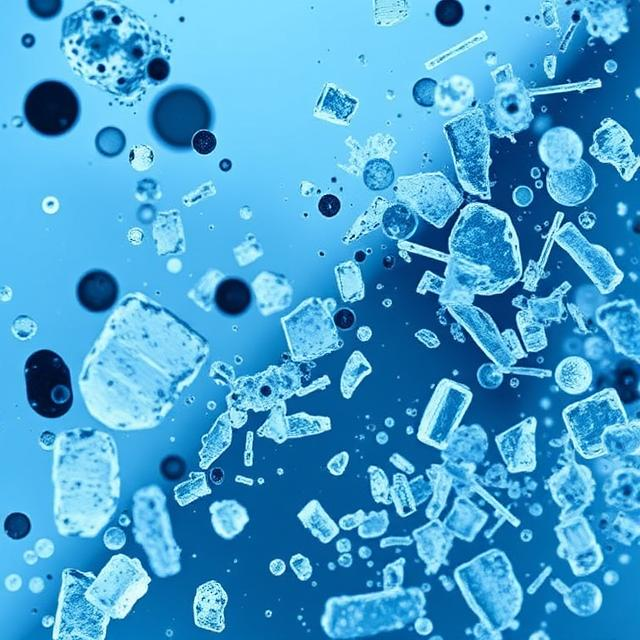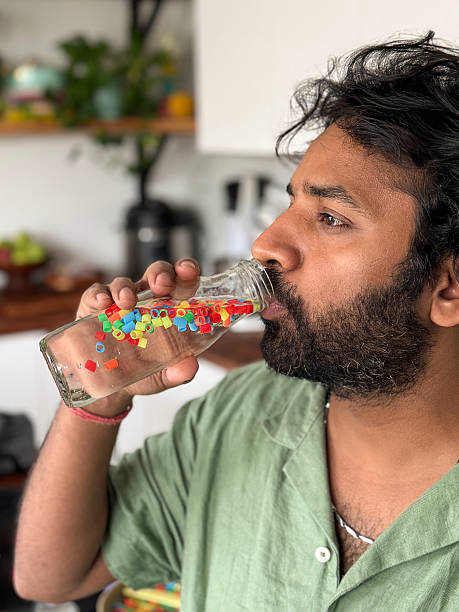How Are Nanoplastics Formed?
Before we get into how nanoplastics form, we first need to understand what they are. Nanoplastics are incredibly small plastic particles—much smaller than microplastics. While microplastics range from 100 nanometers to 5 millimeters, nanoplastics are usually smaller than 100 nanometers. That means they are often invisible to the naked eye and can pass through biological barriers more easily than larger plastic particles.

What Are Nanoplastics?
Because nanoplastics are so tiny, they behave differently than microplastics. Their small size means they can travel through air, water, and soil, and even enter cells in the human body. This makes them especially concerning for both environmental and human health. Unlike larger pieces of plastic that get stuck or filtered out, nanoplastics can go undetected and accumulate inside organs or tissues over time.
While both microplastics and nanoplastics are harmful, nanoplastics pose a more serious risk due to their ability to interact at a cellular level. This difference makes it important to test for plastic exposure regularly using tools like the MicroplastX microplastics blood test kit. Knowing your personal exposure can help you take better steps to reduce it.
Environmental Breakdown Creating Nanoplastics
So how are nanoplastics formed? Most often, they start as larger plastic items—bottles, bags, containers, or industrial waste. Over time, natural forces in the environment break these down into smaller and smaller pieces until they become nanoplastics.
Physical Breakdown Processes
One way nanoplastics are formed is through physical breakdown. This includes exposure to sunlight (also called UV degradation), friction, and temperature changes. For example, when plastic bottles are left outside in the sun, UV rays slowly weaken the plastic until it cracks and fragments. Eventually, those fragments get smaller and smaller, eventually becoming nanoplastics.
Chemical Degradation
Chemicals in the environment also help break down plastics. These include salt from seawater, acids from soil, or pollution in the air. When these chemicals interact with plastic, they cause chemical changes that break the bonds holding the plastic together. This process makes it easier for the plastic to disintegrate into tiny nanoplastics.
Biological Degradation
Another key process is biological degradation. While plastics don’t break down easily, certain bacteria and fungi can slowly chew away at plastic surfaces. These microbes release enzymes that degrade plastic materials into smaller components. Though this process is slow, it still contributes to the formation of nanoplastics, especially in soil and water environments.
As nanoplastics form, they spread easily through rivers, oceans, and even the atmosphere. These particles make their way into our homes, our food, and even our bodies. That’s why at MicroplastX, we’re focused on helping people understand and reduce their personal exposure. Our work and mission, detailed throughout MicroplastX’s mission and team, are grounded in empowering individuals to take action based on real, measurable data.
To truly know if you’ve been exposed to nanoplastics, we recommend taking our personal plastic exposure test. It’s the first step toward understanding what’s in your body—and how to make healthier decisions moving forward.
Human-Made Sources of Nanoplastics
Understanding how nanoplastics are formed requires a close look at human behavior and industrial processes. Many of these tiny particles don’t just come from natural environmental breakdown—they also stem directly from our modern lifestyles and systems of mass production. The question of how nanoplastics are formed is deeply tied to the choices we make every day and the products we use.
Consumer Products That Release Nanoplastics
From cosmetics to synthetic clothing, countless everyday items contribute to nanoplastic formation. Common sources include:
-
Synthetic fabrics: Washing polyester and nylon clothes releases fibers that break down into nanoplastics
-
Personal care products: Exfoliating scrubs, toothpaste, and makeup may contain microplastics that degrade further
-
Plastic packaging: Cutting, heating, or reusing plastic containers accelerates the breakdown process
-
Tires and road dust: Friction from tires creates micro-debris that includes nanoplastics
These items shed microplastic particles through abrasion, heat, or chemical exposure. Over time, many of these particles degrade even further into nanoplastics, making them even harder to detect and more likely to pass into the human body.
If you're asking how nanoplastics are formed in real-world situations, it often begins with overlooked habits like heating food in plastic containers or running synthetic fabrics through the laundry. Each action releases particles into our environment—and often directly into our bodies.
This is where measuring your internal exposure becomes critical. At MicroplastX, we provide a microplastics blood test kit that helps identify and quantify plastic particles in your bloodstream. Understanding how nanoplastics are formed is essential, but knowing how much you’ve absorbed gives you power over your health choices. You can read more about us and our work at MicroplastX, and learn how our team's mission supports your journey to minimize plastic exposure.
Environmental and Health Concerns
Once nanoplastics are in the environment, they spread easily. Because they are so small—often under 100 nanometers—they’re nearly invisible but incredibly invasive. Understanding how nanoplastics are formed helps clarify the massive impact they have once released into ecosystems and our bodies.
How Nanoplastics Travel and Accumulate
Due to their size and light weight, nanoplastics are carried easily through air and water. They can:
-
Enter waterways from household drains and runoff
-
Become airborne from tire particles or waste burning
-
Accumulate in soil and food chains through crops and livestock
These particles have been found in rainwater, ocean sediment, table salt, and even bottled water. When you wonder how nanoplastics are formed, the bigger question becomes: where don’t they go?
Toxicity and Biological Impact
Scientists are still researching the full effects of nanoplastics on health, but early findings suggest major risks. Nanoplastics can:
-
Cross cell membranes, including the blood-brain barrier
-
Interfere with hormone signaling
-
Cause oxidative stress and inflammation
-
Disrupt gut microbiota balance
The environmental impact is just as troubling. Nanoplastics affect marine life, contaminate crops, and create ripple effects across entire ecosystems.
To understand how much these particles have impacted your own health, MicroplastX offers an advanced microplastics blood test that can detect these particles in your bloodstream. This test is an essential tool for those who want to move beyond environmental awareness and take real control of their personal exposure.

We at MicroplastX are committed to turning this knowledge into action. By providing data-driven insights and sharing the science of how nanoplastics are formed, we help you make informed choices that benefit both your body and the planet.
Current Research and Emerging Policies
Understanding how nanoplastics are formed is a fast-moving area of science, and researchers around the world are working to pinpoint exactly how these tiny particles come to exist and impact the planet. Knowing the formation of nanoplastics not only shapes regulations but helps us protect our health. Because the nanoplastics environmental impact spans across ecosystems, the urgency of understanding their formation has become a global priority.
Advances in Nanoplastics Detection
Today’s scientists are using powerful technologies like Raman spectroscopy and electron microscopy to uncover how nanoplastics are formed through the breakdown of larger plastics. These tools help detect nanoplastic particles in environments ranging from oceans to urban air. Every time we ask how are nanoplastics formed, we get closer to tracing the origin and spread of these particles.
Detection breakthroughs show:
-
Nanoplastics appear in rain, snow, and household dust
-
They persist in soil, rivers, and marine organisms
-
They’ve even been found in human blood and placentas
This expanding evidence highlights the nanoplastics environmental impact and reinforces the need for better personal health monitoring. To understand your own exposure, you can use the microplastics blood test kit offered by MicroplastX, which measures plastic levels directly in your bloodstream. It’s one of the only tools available to track the formation of nanoplastics in real life.
Policies Shifting With Science
As more data comes in on how nanoplastics are formed, regulators are starting to act. The European Union and research groups globally are proposing stricter rules for plastic manufacturing and disposal. These changes aim to cut the formation of nanoplastics at the source and reduce their environmental footprint.
But policy takes time. In the meantime, we believe personal action must lead the way. At MicroplastX, our mission is to close the knowledge gap by offering testing backed by real science. Learn how we support better decision-making on our platform for microplastic awareness.
Empowering Consumers Through MicroplastX Testing
Understanding how nanoplastics are formed isn’t just an academic issue—it’s personal. These particles can enter your body through food, water, or air and settle in your organs. That’s why learning about the formation of nanoplastics is the first step. The second is doing something about it.

Personalized Testing Starts With Us
Our MicroplastX microplastics testing solution is designed to give you answers. Using a simple blood sample, we show how much plastic is already circulating in your body. Knowing your levels helps guide your next steps, especially when trying to reduce the nanoplastics environmental impact on your own life.
Here’s what our test helps people do:
-
Understand their internal exposure to nanoplastics
-
Compare test results before and after diet or lifestyle changes
-
Make decisions rooted in real, personalized data
Whether you're filtering your water or switching to non-plastic packaging, it's more powerful when your actions are backed by test results.
The Power of Awareness and Change
Once people realize how nanoplastics are formed and that they’re present in their blood, it’s easier to take proactive steps. Our goal at MicroplastX is to make that information accessible so everyone can respond appropriately.
Many who use our testing platform choose to:
-
Reduce plastic contact in their kitchen and household items
-
Avoid synthetic fibers in clothing
-
Use air purifiers to catch airborne nanoplastics
-
Switch to glass or steel containers for food and drinks
With our blood test for microplastics, the question is no longer “how are nanoplastics formed?”—it’s “what can I do now that I know they’re in me?”
We invite you to learn more on our mission and scientific backing and get started with our nanoplastics detection kit. With MicroplastX, you're not just testing—you're taking control of your exposure.




